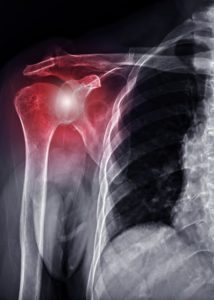Is It a Frozen Shoulder?

Have you ever woken up with a stiff or sore shoulder? It’s likely just due to overuse, strain, or sleeping in an awkward position.
However, if the chronic discomfort doesn’t subside within a few days, especially if the pain is worsening and your range of motion is declining, you might have a more serious underlying condition. The musculoskeletal condition we’ll narrow in on today is called adhesive capsulitis of the shoulder, more commonly known as frozen shoulder.
As the name implies, frozen shoulder will overtime decrease (if not completely inhibit) joint range of motion in the shoulder. The condition is caused by inflammation of the connective tissue capsule surrounding the shoulder joints.
The good news about a frozen shoulder is that after some time of inconvenient gradual worsening, the condition often resolves on its own! The bad news is that the condition can last for one to three years. And the worse news is that, if left untreated, surgery might be required to reverse the condition.
So, can something be done along the recovery journey to prevent the need for surgery? Absolutely! At Moyer Total Wellness, we have a four-step treatment approach that can ease your shoulder joint’s way out of its connective tissue prison. But first, let’s do some recap on the symptoms and reveal who is at highest risk.
Symptoms
For those of you who skipped the introduction and scrolled straight to the symptoms heading, let’s reiterate the symptoms of frozen shoulder!
- Loss or significant decrease in shoulder joint range of motion
- Dull or achy pain in shoulder joints
- Pain and stiffness in shoulder muscles
The condition usually only affects one shoulder at a time. Frozen shoulder can recur after it resolves, but is less likely to resurface in the shoulder previously affected.
Who is at Highest Risk?
People who keep their arms immobilized for long periods of time are at highest risk for developing a frozen shoulder. Individuals likely to fall into this category have, or have had, at least one of the following:
- Stroke
- Mastectomy
- Broken arm
- Rotator cuff injury
Common conditions associated with a frozen shoulder include diabetes, heart disease, hyperthyroidism, hypothyroidism, and Parkinson’s disease.
The Four-Step Treatment Approach
There are four goals in our treatment approach at Moyer Total Wellness:
- Remove muscular adhesions
- Lengthen constricted tissues
- Mobilize joints
- Strengthen weak muscles
The muscles taking the brunt from a frozen shoulder are located in the rotator cuff. These muscles include the subscapularis, supraspinatus, infraspinatus, and teres minor. Deep tissue massage and myofascial release therapy are most effective at removing muscular adhesions and lengthening constricted muscular tissue. Keep in mind though, having these specific muscles palpated can be uncomfortable with or without a frozen shoulder. They are rife with tender trigger points, especially the much-neglected subscapularis hiding inside your armpit!
Speaking of trigger points, did you know that those nasty little cesspools of lactic acid are restricting your range of motion? They’re keeping your muscles short and stiff! That’s why trigger point therapy can be incorporated into a deep tissue massage addressing a frozen shoulder. Relieving those trigger points will assist with the deep tissue’s goals of adhesion removal and tissue lengthening, as well as improve the impacted range of motion.
What happens when rotator cuff muscles loosen, the shortened tissues lengthen, and the shoulder joints regain mobilization? The targeted area is ready to have the fourth goal undertaken: strengthen weak muscles. When muscles are tight and short, they don’t function properly. A dysfunctional muscle, unable to carry out tasks as adequately as a healthy muscle, will weaken over time. But when the three previously mentioned goals are achieved, the shoulder can be treated with therapeutic stretching. Proprioceptive neuromuscular facilitation (PNF) stretching is a modality used to improve strength and flexibility of a specific muscle group. It’s most effective when performed at the end of a massage, as loosened muscular tissue responds most effectively to assisted stretching.
Prevention
After the frozen shoulder resolves itself, the last thing you want is for the condition to resurface. What can be done post-recovery to keep the shoulders mobile and healthy?
- Joint range of motion exercises
-
- Ask a medical professional about the safest and most effective exercises that address the shoulder joints
-
- Massage therapy
-
- Joint range of motion exercises can be incorporated into the massage
-
- Therapeutic stretching
-
- Assisted stretching can be performed by a massage therapist, chiropractor, physical therapist, or personal trainer
- Ask a medical professional to demonstrate stretches that can be safely performed at home
-
- Practicing good posture
- Boosting immunity
Now you know!
Schedule an appointment with one of our talented massage therapists! Unfreeze your shoulders!

Katrina Jenkins
Author, Licensed Massage Therapist
Katrina Jenkins graduated from Towson University in 2013 with a Bachelor’s Degree in Health Science and worked as a nurse’s aide briefly before pursuing her true passion. She graduated from the Massage Therapy Institute of Colorado in April 2016 with honors and completed the Touch of Healers Scholarship Program the following summer. She has been a part of the Moyer Total Wellness Team since the summer of 2017.
Resources
“Frozen Shoulder.” Www.hopkinsmedicine.org, www.hopkinsmedicine.org/health/conditions-and-diseases/frozen-shoulder.
“Frozen Shoulder – Symptoms and Causes.” Mayo Clinic, 1 Aug. 2020, www.mayoclinic.org/diseases-conditions/frozen-shoulder/symptoms-causes/syc-20372684.
Mezian, Kamal, and Ke-Vin Chang. “Frozen Shoulder.” PubMed, StatPearls Publishing, 2020, www.ncbi.nlm.nih.gov/books/NBK482162/.
Wheeler, Tyler. “What Is a Frozen Shoulder?” WebMD, 18 Mar. 2021, www.webmd.com/a-to-z-guides/what-is-a-frozen-shoulder#:~:text=Frozen%20shoulder%20is%20a%20condition.
Photo Credit
Canva by chokja
Canva by mr.suphachai praserdumrongchai

